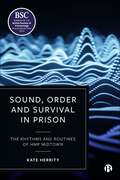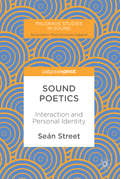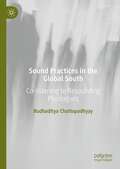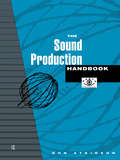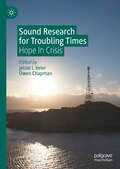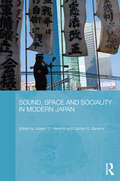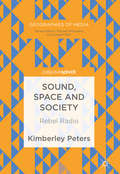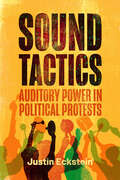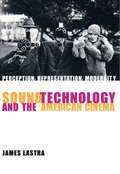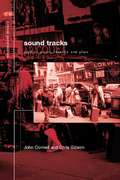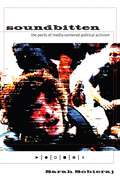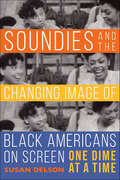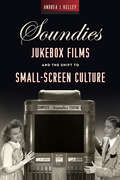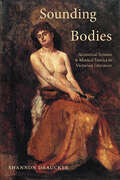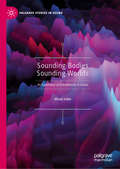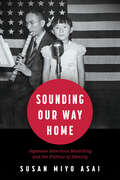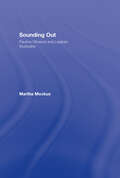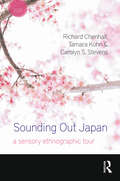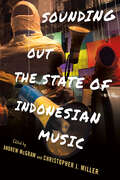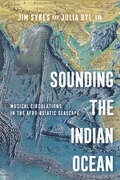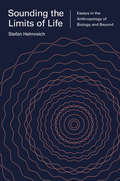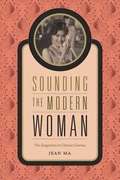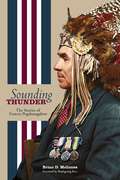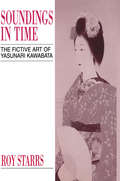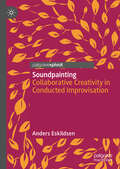- Table View
- List View
Sound, Order and Survival in Prison: The Rhythms and Routines of HMP Midtown
by Kate HerrityThe soundscape of prison life is that of constant clangs, bangs and jangles. What is the significance of this cacophonous din to those who live and work with it? This book tells the story of a year spent with a UK prison community, bringing its social world vividly to life for the first time through aural ethnography. Kate Herrity’s sensory criminology challenges current thinking on how power is experienced by the imprisoned and the lasting effects of incarceration for all who spend time in these environments.
Sound Poetics
by Seán StreetThis book examines sonic signals as something both heard internally and externally, through imagination, memory and direct response. In doing so it explores how the mind 'makes' sound through experience, as it interprets codes on the written page, and creates an internal leitmotif that then interacts with new sounds made through an aural partnership with the external world, chosen and involuntary exposure to music and sound messages, both friendly and antagonistic to the identity of the self. It creates an argument for sound as an underlying force that links us to the world we inhabit, an essential part of being in the same primal sense as the calls of birds and other inhabitants of a shared earth. Street argues that sound as a poetic force is part of who we are, linked to our visualisation and sense of the world, as idea and presence within us. This incredibly interdisciplinary book will be of great interest to scholars of radio, sound, media and literature as well as philosophy and psychology.
Sound Practices in the Global South: Co-listening to Resounding Plurilogues
by Budhaditya ChattopadhyayThis book develops a comprehensive understanding of the unique sound worlds of key regions in the Global South, through an auto-ethnographic method of self-reflective conversations with prominent sound practitioners from South Asia, Africa, the Middle East and Latin America. The conversations navigate various trajectories of sound practices, illuminating intricate sonic processes of listening, thinking through sounds, ideating, exposing, and performing with sound. This collection of conversations constitutes the main body of the book, including critical and scholarly commentaries on aural cultures, sound theory and production. The book builds a ground-up approach to nurturing knowledge about aural cultures and sonic aesthetics, moving beyond the Eurocentric focus of contemporary sound studies. Instead of understanding sound practices through consumption and entertainment, they are explored as complex cultural and aesthetic systems, working directly with the practitioners themselves, who largely contribute to the development of the sonic methodologies. Refocusing on the working methods of practitioners, the book reveals a tension between the West’s predominant colonial-consumerist cultures, and the collective desires of practitioners to resist colonial models of listening by expressing themselves in terms of their arts and craft, and their critical faculties.Conversations with: Clarence Barlow, Sandeep Bhagwati, Rajesh K. Mehta, Sharif Sehnaoui, Ximena Alarcón Díaz, Hardi Kurda, Mario de Vega, Luka Mukhavele, Khyam Allami, Cedrik Fermont, Khaled Kaddal, David Velez, Juan Duarte, Youmna Saba, Abdellah M. Hassak, Mariana Marcassa, Amanda Gutiérrez, Syma Tariq, Alma Laprida, Siamak Anvari, Mohamad Safa, Debashis Sinha, Zouheir Atbane, Constanza Bizraelli, Jatin Vidyarthi, Joseph Kamaru, Surabhi Saraf, Isuru Kumarasinghe, Hemant Sreekumar.
The Sound Production Handbook
by Don AtkinsonFirst Published in 1995. Routledge is an imprint of Taylor & Francis, an informa company.
Sound Research for Troubling Times: Hope In Crisis
by Jessie L. Beier Owen ChapmanThis edited collection takes the prompt “hope in crisis” as a starting point for investigating sound research as it is situated in these troubling times. The book brings together thinkers from numerous scholarly domains (i.e. communication studies, art education, creative art therapy, psychology and philosophy) to explore the question of hope as it relates to sonic research-creation practices in/and times of crisis. Some of the prompts and provocations explored by the authors within the collection include, but are not limited to: explorations of sonic research-creation practices as they are situated within contemporary convergence of crises; theoretical investigations of the concept of hope as it relates to sonic temporalities, ontologies, and epistemologies; articulations of experimental sonic pedagogies; examinations of hope as it plays out in institutional settings and/or sound and music scenes (i.e. music education, artistic communities, activist communities); investigations of experimental listening practices as they relate to contemporary crises; explorations of post-human, non-human, and inhuman sonic resonances in research-creation practices; and experimental practices that deploy sound and sonic approaches for emergent, collective research both within, but also outside of, academic institutions. Positioned as a material that holds the potential to frustrate common approaches to research, whether through its refusal of occularcentric perspectives, its leaky data protocols or its distortion of future horizons, sound is explored here as that which might counter the default refrains that have pushed hope itself into crisis. Importantly, while sound research is explored in this book in relation to hope, it is not offered up as a better way forward, nor is it presented as a solution. Sound research is instead posed as a question, with each author responding in their own way through experiments with the potentials, but also limits, of and for sonic practices. Central to the project, then, is the question of how to collectively and creatively respond to the increasingly difficult— even untenable—circumstances that have come to limit future possibilities, both within fields of research but also beyond, without falling back on the unquestioned assumption that hope alone will actualize a desired otherworld. The sound research gathered here experiments with such possibilities in order to grapple with how present conditions, including conditions for research, are always contingent—always already in trouble—and thus also subject to change both conceptually and materially.
Sound, Space and Sociality in Modern Japan (Routledge Contemporary Japan Series)
by Joseph D. Hankins Carolyn S. StevensThis book argues that sound – as it is created, transmitted, and perceived – plays a key role in the constitution of space and community in contemporary Japan. The book examines how sonic practices reflect politics, aesthetics, and ethics, with transformative effects on human relations. From right-wing sound trucks to left-wing protests, from early 20th century jazz cafes to contemporary avant-garde art forms, from the sounds of U.S. military presence to exuberant performances organized in opposition, the book, rich in ethnographic detail, contributes to sensory anthropology and the anthropology of contemporary Japan.
Sound, Space and Society
by Kimberley PetersIn 1964, rebel radio stations took to the seas in converted ships to offer listening choice to a young, resistant audience, against a backdrop of restrictive broadcasting policies. This book draws on this exceptional moment in social history, and the decades that followed, teasing out the relations between sound, society and space that were central to 'pirate' broadcasting activities. With a turn towards mediated life in geography, studies of radio have been largely absent. However, radio remains the most pervasive mass communications medium. This book breaks new ground, discussing in depth the relationship between radio, space and society; considering how space matters in the production, consumption and regulation of audio transmission, through the geophysical spaces of sea, land and air. It is relevant for readers interested in geographies of media, sensory spatial experience, everyday geopolitics and the turn towards elemental and more-than-human geographies.
Sound Tactics: Auditory Power in Political Protests (RSA Series in Transdisciplinary Rhetoric)
by Justin EcksteinFrom call and response chants to the noise of pots and pans, protests are often defined by their sounds. In this book, Justin Eckstein argues that this is not merely the result of catchy slogans; it is due to sound’s ability to hold those in power accountable. Sound Tactics highlights how, in a world grappling with the uncertainty of emergent digital practices, social movements utilize the rhetorical power of sound.Eckstein uses the waveform as a metaphor for the persuasive potential of sound. Examining the case studies of the March for Our Lives protest, Howard University’s HUResist movement, and the Casseroles protest in Montreal, Eckstein demonstrates how changes to the immediacy, intensity, and immersiveness of sound can affect the power of an argument. The collective use of sound in these case studies conveys the unity of the protestors in their demand for change and underlines the strength of their argument to those in power.More than just the written word spoken aloud, sound has unique layers of added meaning—it can convey length of time, demand attention, and signal disapproval. Eckstein’s study unpacks those layers for scholars and students, as well as activists interested in deploying sound for change.
Sound Technology and the American Cinema: Perception, Representation, Modernity (Film and Culture Series)
by James LastraRepresentational technologies including photography, phonography, and the cinema have helped define modernity itself. Since the nineteenth century, these technologies have challenged our trust of sensory perception, given the ephemeral unprecedented parity with the eternal, and created profound temporal and spatial displacements. But current approaches to representational and cultural history often neglect to examine these technologies. James Lastra seeks to remedy this neglect.Lastra argues that we are nowhere better able to track the relations between capital, science, and cultural practice than in photography, phonography, and the cinema. In particular, he maps the development of sound recording from its emergence to its confrontation with and integration into the Hollywood film.Reaching back into the late eighteenth century, to natural philosophy, stenography, automata, and human physiology, Lastra follows the shifting relationships between our senses, technology, and representation.
Sound Tracks: Popular Music Identity and Place (Critical Geographies)
by Chris Gibson John ConnellSound Tracks is the first comprehensive book on the new geography of popular music, examining the complex links between places, music and cultural identities. It provides an interdisciplinary perspective on local, national and global scenes, from the 'Mersey' and 'Icelandic' sounds to 'world music', and explores the diverse meanings of music in a range of regional contexts.In a world of intensified globalisation, links between space, music and identity are increasingly tenuous, yet places give credibility to music, not least in the 'country', and music is commonly linked to place, as a stake to originality, a claim to tradition and as a marketing device. This book develops new perspectives on these relationships and how they are situated within cultural and geographical thought.
Soundbitten: The Perils of Media-Centered Political Activism
by Sarah SobierajThere is an elaborate and often invisible carnival that emerges alongside presidential campaigns as innumerable activist groups attempt to press their issues into mainstream political discourse. Sarah Sobieraj’s fascinating ethnographic portrait of fifty diverse organizations over the course of two campaign cycles reveals that while most activist groups equate political success with media success and channel their energies accordingly, their efforts fail to generate news coverage and come with deleterious consequences. Sobieraj shows that activists’ impact on public political debates is minimal, and carefully unravels the ways in which their all-consuming media work and unrelenting public relations approach undermine their ability to communicate with pedestrians, comes at the expense of other political activities, and perhaps most perniciously, damages the groups themselves.Weaving together fieldwork, news analysis, and in-depth interviews with activists and journalists, Soundbitten illuminates the relationship between news and activist organizations. This captivating portrait of activism in the United States lays bare the challenges faced by outsiders struggling to be heard in a mass media dominated public sphere that proves exclusionary and shows that media-centrism is not only ineffective, but also damaging to group life. Soundbitten reveals why media-centered activism so often fails, what activist groups lose in the process, and why we should all be concerned.
Soundies and the Changing Image of Black Americans on Screen: One Dime at a Time
by Susan DelsonIn the 1940s, folks at bars and restaurants would gather around a Panoram movie machine to watch three-minute films called Soundies, precursors to today's music videos. This history was all but forgotten until the digital era brought Soundies to phones and computer screens—including a YouTube clip starring a 102-year-old Harlem dancer watching her younger self perform in Soundies. In Soundies and the Changing Image of Black Americans on Screen: One Dime at a Time, Susan Delson takes a deeper look at these fascinating films by focusing on the role of Black performers in this little-known genre. She highlights the women performers, like Dorothy Dandridge, who helped shape Soundies, while offering an intimate look at icons of the age, such as Duke Ellington and Nat King Cole. Using previously unknown archival materials—including letters, corporate memos, and courtroom testimony—to trace the precarious path of Soundies, Delson presents an incisive pop-culture snapshot of race relations during and just after World War II.Perfect for readers interested in film, American history, the World War II era, and Black entertainment history, Soundies and the Changing Image of Black Americans on Screen and its companion video website (susandelson.com) bring the important contributions of these Black artists into the spotlight once again.
Soundies Jukebox Films and the Shift to Small-Screen Culture (Techniques of the Moving Image)
by Andrea J. KelleySoundies Jukebox Films and the Shift to Small-Screen Culture is the first and only book to position what are called “Soundies” within the broader cultural and technological milieu of the 1940s. From 1940 to 1946, these musical films circulated in everyday venues, including bars, bowling alleys, train stations, hospitals, and even military bases. Viewers would pay a dime to watch them playing on the small screens of the Panoram jukebox. This book expands U.S. film history beyond both Hollywood and institutional film practices. Examining the dynamics between Soundies’ short musical films, the Panoram’s film-jukebox technology, their screening spaces and their popular discourse, Andrea J. Kelley provides an integrative approach to historic media exhibition. She situates the material conditions of Soundies’ screening sites alongside formal considerations of the films and their unique politics of representation to illuminate a formative moment in the history of the small screen.
Sounding Bodies: Acoustical Science and Musical Erotics in Victorian Literature (SUNY series, Studies in the Long Nineteenth Century)
by Shannon DrauckerCan the concert hall be as erotic as the bedroom? Many Victorian writers believed so. In the mid-nineteenth century, acoustical scientists such as Hermann von Helmholtz and John Tyndall described music as a set of physical vibrations that tickled the ear, excited the nerves, and precipitated muscular convulsions. In turn, writers—from canonical figures such as George Eliot and Thomas Hardy, to New Women novelists like Sarah Grand and Bertha Thomas, to anonymous authors of underground pornography—depicted bodily sensations and experiences in unusually explicit ways. These writers used scenes of music listening and performance to intervene in urgent conversations about gender and sexuality and explore issues of agency, pleasure, violence, desire, and kinship. Sounding Bodies shows how both classical music and Victorian literature, while often considered bastions of conservatism and repression, represented powerful sites for feminist and queer politics.
Sounding Bodies Sounding Worlds: An Exploration of Embodiments in Sound (Palgrave Studies in Sound)
by Mickey ValleeWhat makes a body of sound appear as an aesthetic object as well as a method for knowledge? In Sounding Bodies Sounding Worlds, Mickey Vallee argues that we must impose our sonic imagination onto the non-sonic, and embrace how we sound to ourselves, sound with our animal companions, and sound in very earth itself. From the invention of the laryngoscope to the role of the spectrogram, from the call of the bird to the tumble of a rockslide, from the deep listening of environmental immersion to the computational listening of bioacoustics research, Vallee offers a wide range of cases to convincingly argue that all life shares in a continuous, embodied and ethical vibration.
Sounding Our Way Home: Japanese American Musicking and the Politics of Identity
by Susan Miyo AsaiA product of twenty-five years of archival and primary research, Sounding Our Way Home: Japanese American Musicking and the Politics of Identity narrates the efforts of three generations of Japanese Americans to reach “home” through musicking. Using ethnomusicology as a lens, Susan Miyo Asai examines the musical choices of a population that, historically, is considered outside the racial and ethnic boundaries of American citizenship. Emphasizing the notion of national identity and belonging, the volume provokes a discussion about the challenges of nation-building in a democratic society.Asai addresses the politics of music, interrogating the ways musicking functions as a performance of social, cultural, and political identification for Japanese Americans in the United States. Musicking is an inherently political act at the intersection of music, identity, and politics, particularly if it involves expressing one’s ethnicity and/or race. Asai further investigates how Japanese American ethnic identification and cultural practices relate to national belonging. Musicking cultivates a narrative of a shared history and aesthetic between performers and listeners. The discourse situates not only Japanese Americans, but all Asians into the Black/white binary of race relations in the United States.Sounding Our Way Home contributes to the ongoing struggle for acceptance and equal representation for people of color in the US. A history of Japanese American musicking across three generations, the book unveils the social and political discrimination that nonwhite immigrants and their offspring continue to face when it comes to finding acceptance in US society and culture.
Sounding Out: Pauline Oliveros And Lesbian Musicality
by Martha MockusSounding Out: Pauline Oliveros and Lesbian Musicality examines the musical career of the avant-garde composer, accordionist, whose radical innovations of the 1960s, 70s and 80s have redefined the aesthetic and formal parameters of American experimental music. While other scholars have studied Oliveros as a disciple of John Cage and a contemporary of composers Terry Riley, Lou Harrison, Gordon Mumma, and Robert Ashley, Sounding Out resituates Pauline Oliveros in a gynecentric network of feminist activists, writers, artists and musicians. This book shows how the women in Oliveros’s life were central sources of creative energy and exchange during a crucial moment in feminist and queer cultural history. Crafting a dynamic relationship between feminism and music-making, this book offers a queerly original analysis of Oliveros’s work as a musical form of feminist activism and argues for the productive role of experimental music in lesbian feminist theory. Sounding Out combines key elements of feminist theories of lesbian sexuality with Oliveros’s major compositions, performances, critical essays, and interviews. It also includes previously unpublished correspondence between Oliveros and Edith Guttierez, Jill Johnston, Annea Lockwood, Kate Millett, and Jane Rule.
Sounding Out Japan: A Sensory Ethnographic Tour (Sensory Studies)
by Richard Chenhall Tamara Kohn Carolyn S. StevensThis book takes the reader on a sensory ethnographic tour in Japan and describes the many ways sounds seep into everyday experiences. So many ethnographies describe local worlds with a deep attention to what is seen and what people say, but with a limited understanding of the broader sonic environments that enrich and inform everyday life. Through a focus on sounds, both real and imagined, the volume employs a critical ear to engage with a range of sonically enriched encounters, including crosswalk melodies in streetscapes, announcements and jingles at train stations, water features in gardens, dosimeters in nuclear affected zones, sounds of training in music and martial arts halls and celebrations under blossoming cherry trees. The authors use various analytic frames to understand the communicative and symbolic aspects of sounds and to sense the layers of historical meaning, embodied action and affect associated with sonic environments.
Sounding Out the State of Indonesian Music (Cornell Modern Indonesia Project)
by Andrew McGraw Christopher J. MillerSounding Out the State of Indonesian Music showcases the breadth and complexity of the music of Indonesia. By bringing together chapters on the merging of Batak musical preferences and popular music aesthetics; the vernacular cosmopolitanism of a Balinese rock band; the burgeoning underground noise scene; the growing interest in kroncong in the United States; and what is included and excluded on Indonesian media, editors Andrew McGraw and Christopher J. Miller expand the scope of Indonesian music studies. Essays analyzing the perception of decline among gamelan musicians in Central Java; changes in performing arts patronage in Bali; how gamelan communities form between Bali and North America; and reflecting on the "refusion" of American mathcore and Balinese gamelan offer new perspectives on more familiar topics.Sounding Out the State of Indonesian Music calls for a new paradigm in popular music studies, grapples with the imperative to decolonialize, and recognizes the field's grounding in diverse forms of practice.
Sounding the Indian Ocean: Musical Circulations in the Afro-Asiatic Seascape
by Prof. Jim Sykes Prof. Julia Suzanne BylA free ebook version of this title is available through Luminos, University of California Press’s Open Access publishing program. Visit www.luminosoa.org to learn more.Sounding the Indian Ocean is the first volume to integrate the fields of ethnomusicology and Indian Ocean studies. Drawing on historical and ethnographic approaches, the book explores what music reveals about mobility, diaspora, colonialism, religious networks, media, and performance. Collectively, the chapters examine different ways the Indian Ocean might be "heard" outside of a reliance on colonial archives and elite textual traditions, integrating methods from music and sound studies into the history and anthropology of the region. Challenging the area studies paradigm—which has long cast Africa, the Middle East, and Asia as separate musical cultures—the book shows how music both forms and crosses boundaries in the Indian Ocean world.
Sounding the Limits of Life
by Sophia Roosth Michele Friedner Stefan HelmreichWhat is life? What is water? What is sound? In Sounding the Limits of Life, anthropologist Stefan Helmreich investigates how contemporary scientists--biologists, oceanographers, and audio engineers--are redefining these crucial concepts. Life, water, and sound are phenomena at once empirical and abstract, material and formal, scientific and social. In the age of synthetic biology, rising sea levels, and new technologies of listening, these phenomena stretch toward their conceptual snapping points, breaching the boundaries between the natural, cultural, and virtual.Through examinations of the computational life sciences, marine biology, astrobiology, acoustics, and more, Helmreich follows scientists to the limits of these categories. Along the way, he offers critical accounts of such other-than-human entities as digital life forms, microbes, coral reefs, whales, seawater, extraterrestrials, tsunamis, seashells, and bionic cochlea. He develops a new notion of "sounding"--as investigating, fathoming, listening--to describe the form of inquiry appropriate for tracking meanings and practices of the biological, aquatic, and sonic in a time of global change and climate crisis.Sounding the Limits of Life shows that life, water, and sound no longer mean what they once did, and that what count as their essential natures are under dynamic revision.
Sounding the Modern Woman: The Songstress in Chinese Cinema
by Jean MaFrom the beginning of the sound cinema era, singing actresses captivated Chinese audiences. In Sounding the Modern Woman, Jean Ma shows how their rise to stardom attests to the changing roles of women in urban modernity and the complex symbiosis between the film and music industries. The songstress--whether appearing as an opera actress, showgirl, revolutionary, or country lass--belongs to the lineage of the Chinese modern woman, and her forty year prevalence points to a distinctive gendering of lyrical expression in Chinese film. Ma guides readers through film history by way of the on and off-screen careers of many of the most compelling performers in Chinese film history, such as Zhou Xuan and Grace Chang, revealing the ways that national crises and Cold War conflict shaped their celebrity. As a bridge between the film cultures of prewar Shanghai and postwar Hong Kong, the songstress brings into view a dense web of connections linking these two periods and places that cut across the divides of war, national politics, and geography.
Sounding Thunder: The Stories of Francis Pegahmagabow
by Brian D. Mcinnes Waubgeshig RiceFrancis Pegahmagabow (1889–1952), a member of the Ojibwe nation, was born in Shawanaga, Ontario. Enlisting at the onset of the First World War, he became the most decorated Canadian Indigenous soldier for bravery and the most accomplished sniper in North American military history. After the war, Pegahmagabow settled in Wasauksing, Ontario. He served his community as both chief and councillor and belonged to the Brotherhood of Canadian Indians, an early national Indigenous political organization. Francis proudly served a term as Supreme Chief of the National Indian Government, retiring from office in 1950. Francis Pegahmagabow’s stories describe many parts of his life and are characterized by classic Ojibwe narrative. They reveal aspects of Francis’s Anishinaabe life and worldview. Interceding chapters by Brian McInnes provide valuable cultural, spiritual, linguistic, and historic insights that give a greater context and application for Francis’s words and world. Presented in their original Ojibwe as well as in English translation, the stories also reveal a rich and evocative relationship to the lands and waters of Georgian Bay. In "Sounding Thunder", Brian McInnes provides new perspective on Pegahmagabow and his experience through a unique synthesis of Ojibwe oral history, historical record, and Pegahmagabow family stories.
Soundings in Time: The Fictive Art of Yasunari Kawabata
by Roy StarrsThis first full length, and long overdue, study of Kawabata, Japans first Nobel laureate for literature and the most widely known for his novels Snow Country (1960) and Sound of the Mountain (1970).
Soundpainting: Collaborative Creativity in Conducted Improvisation (Palgrave Studies in Sound)
by Anders EskildsenThis book explores Soundpainting, a multidisciplinary sign language for live composition and conducted improvisation, highlighting its role in facilitating creative, social interactions in music and other performative arts. Examining the meaning of Soundpainting’s syntax, the connection between constraints and creativity in hand signs, and the means for dynamic distribution and transformation of agency within ensembles, the book provides insight into the nature of cocreation and the organization of creative processes.
